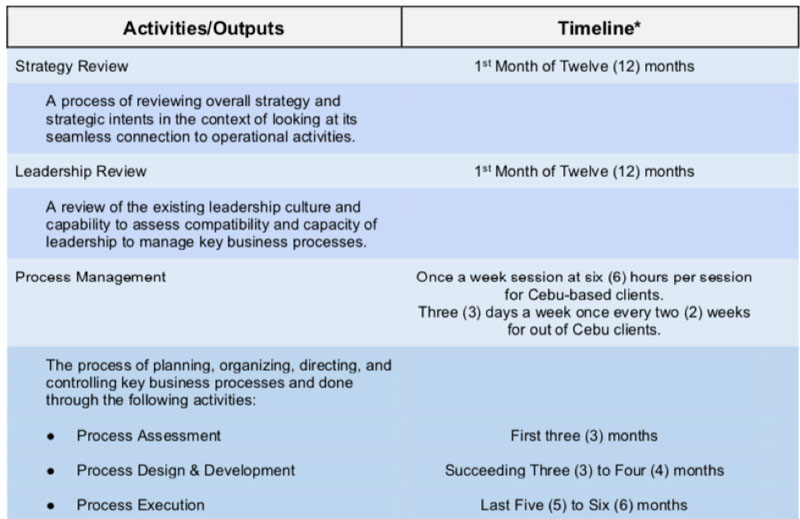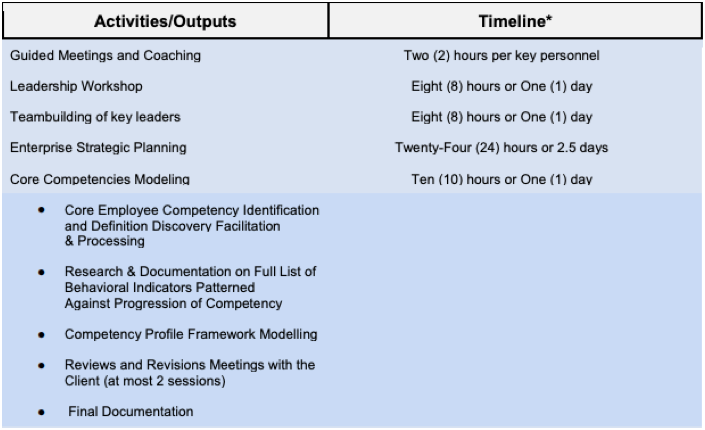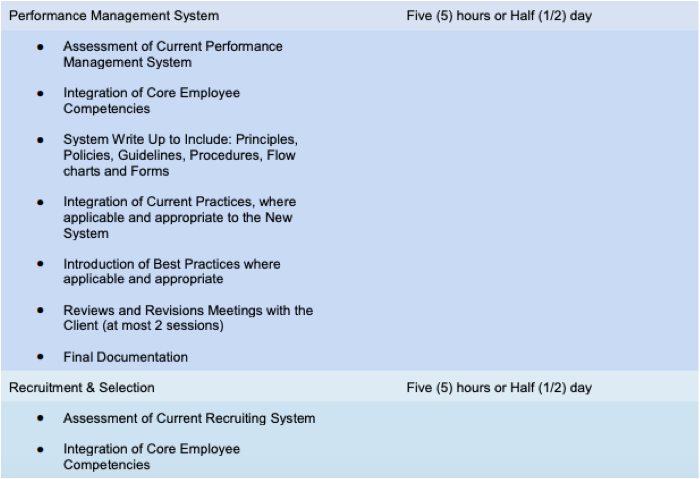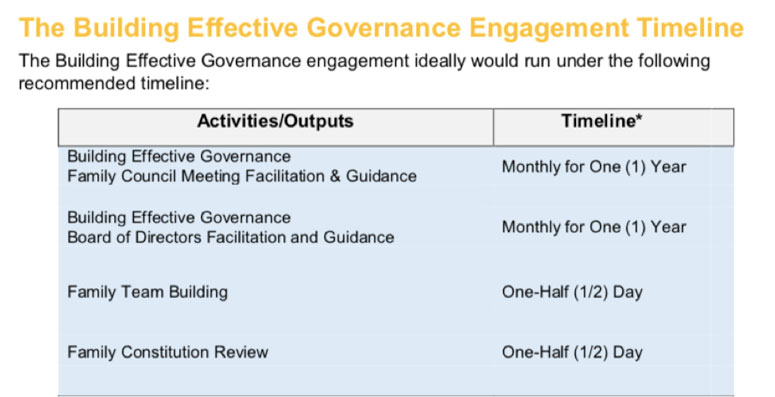FREQUENTLY ASKED QUESTIONS
FAMILY ENTERPRISE PLANNING (FEP)
1What is Family Enterprise Planning (FEP)?
FEP is a planning process for families in business. It strengthens foremost the family culture, clarifies policies and directions. FEP has four main processes:
1) Family Culture Building;
2) Ownership Succession Planning;
3) Leadership Succession Planning;
4) and Family Financial Planning.
The whole program is designed to leave a lasting legacy of sustainability across generations. It perpetuates harmony and equips the family to navigate through challenges ahead.
2What are the Components of the Family Enterprise Planning (FEP)?
1. Family Culture Building
At the heart of every family are complex dynamics that need to be processed. Family Culture Building bridges these gaps and allow for family members to go back and to return to the core - of family love.
Family Unity Sustains Business Prosperity
At the heart of the Planning Process is Family Unity Building. With Family Unity Building, you can pass on the family values and culture that makes the family succeed and set the mission, vision and direction of the family.
Guided Discovery
Interviews with the family members to establish baselines of individual family members’ concerns, hopes, and dreams.
Family Culture Building
Process a one day family visioning workshop to rediscover the family’s shared history, values and culture.
2. Ownership Succession Planning
In time Founders need to pass on ownership of the business. But these too are complex and sometimes lead to conflicts. Ownership Succession Planning address these existing or prospective conflicts through family communication, consensus-building and planning.
Prepare Keep wealth within the family by making the family united.
Through the Ownership Succession Plan, you can preserve the success of the Family Enterprise and leave tangible legacy for your Family’s next generation.
Estate Plan
Preparation Dialogue for Ownership Succession with
Founders and Family Members
Development of Right Ownership Structure / Model
Organization of Family Assets and Liabilities
Estate Tax Planning
Family Estate Valuation System
Asset Protection
Family Assets And Ownership Risks Assessment
Craft Agreements to enforce Policies and Protect
Shares Of Stocks/Family Assets
3. Leadership Succession Planning
To perpetuate the family business, leadership in time needs to be passed on to the next generation. But how can this be done seamlessly? Leadership Succession Planning is a facilitation process where family members get to agree on leadership and as to how a smooth transition can take place.
Next Generation of Leaders to Succeed
Through Leadership Succession Planning ensure that prosperity of the business is continued and the unity of the family sustained.
Family Retreat
Process a family retreat to craft the family constitution
Establish family governance structures
Study and Recommend Best-suited Governance
Establish the Family Council
Facilitate one BOD and /or Family Council Meeting
Retirement Planning of Founder
4. Family Financial Planning
At the end of the day resources matter a lot. With Family Financial Planning, valuable assets are strategized to become effective tools to sustain the family business. Family Financial Planning provide the members of the family business with the best possible options to grow and thrive and thus create more resources and wealth.
Balancing the Needs of the Family & the Business
Through Family Financial Planning, you assure the good life of the family regardless of the business’ risks. And without hampering business capital.
• Financial Goal Coaching
• Personal Cash Management
• Risk Management Plan
• Education Plan
• Retirement Plan
• Investment Plan
3How Long Does the FEP Process Take?

KEY PROCESS MANAGEMENT CONSULTING (KPMC)
1What is Key Process Management Consulting (KPMC)?
Premier’s Key Process Management Consulting (KPMC) offers a solution to the challenges commonly faced by growing enterprises or family businesses who are leveraging on their growth phase to scale up to more ambitious level of operations.
2What are the Components of KPMC?
1. Operations Management
• The direct link to strategy is execution. This refers to the cluster and series of interconnected processes and activities that ensure the creation, delivery, and improvement of your value proposition translated into your products and services. The management of operations is key to sustainability and growth.
2. Human Resource Management
• The challenges of human resource management start from the first man or woman you hire to do work for you. From the time you recruited them up to the time the person separates either by his or her own volition (resignation) or by your action (termination), the legal and financial ramifications of accepting and separating an employee have made the management of any organization complex and daunting. It now requires more complex knowledge and more experienced minds to get the most from your human resource.
3. Financial Management
• Next to human resource is the management of your finances. You need to be good at how to source them, use them, manage the cost of money, track expenditures or make decisions to buy, invest, borrow or retain earnings. The complexity of understanding the real value of money, investment, and risks require specialized knowledge and skills.
4. Facilities Management
• To ensure that built environment (factories, hospitals, hotels, sports complexes, jails, school campuses, offices, warehouses, condominiums, industrial zones, etc.) are functioning as designed, a set of disciplines are harnessed that integrates people, place, process, and technology.
• This key process requires knowledge, expertise, and skills in climate control, power, utilities, business continuity, sanitation, waste management, security, engineering, etc.
5. Reputation-Brand Management
• Previously the realm of public relations, reputation and brand management are becoming more and more a key process in the context of an organization’s web presence. Although, social media and Internet are integral part of reputation and branding, reputation is still a process that encompasses both online and offline spheres. Companies with considerable market share need to maintain and protect their logos or tradename and need to be careful where these logos or trademarks appear.
6. Intellectual Property Management
• Intellectual properties are assets just like buildings or cash. To original equipment manufacturers or OEMs, these translates to tangible products and leading innovations that drives revenue. In many industries, intellectual property forms the core of an organization’s capital, the value of which until today is difficult to calculate even with the many approaches to its valuation. The process of intellectual property managements requires technical, business, and legal knowledge and expertise.
7. Knowledge Resource Management
• Like intellectual property, a company’s knowledge resource represents an ongoing challenge to property valuation. It is very difficult to calculate the impact of knowledge in the company’s overall strategy and even more difficult to translate into an asset with a corresponding currency value. The absence of proper knowledge resource management however can be calculated in terms of hours of outsourced training, poor quality management, poor decision-making results, talent attrition, etc.
3How Does the KPMC Process Work?
1. Strategy Review
• A process of reviewing overall strategy and strategic intents in the context of looking at its seamless connection to operational activities.
2. Leadership Review
• A review of the existing leadership culture and capability to assess compatibility and capacity of leadership to manage key business processes.
3. Process Management
• The process of planning, organizing, directing, and controlling key business processes and done through the following activities:
a. Process Assessment
The systematic documentation of existing activities and processes link to strategic initiatives in view of standardization and future inputs for learning. This includes tracking revisions and changes in the processes and its relevant documents. Documents should cover inputs, procedures, and outputs includes editing, writing, and compilation of procedures.
b. Process Design & Development
Introduction of changes, revisions and even new processes to activate initiatives directly link to strategic intents. The focus of these changes, revisions, and introduction of new processes is to ensure the consistent quality of delivery of products and services according to customer requirements. This includes data gathering, articulation, and development of procedures.
c. Process Execution
Roll-out of key processes or the implementation of agreed upon activities supporting the strategic initiatives. This also covers the reporting of phase-by-phase implementation of the roll-out to management or business owners. This activity has an option of recommending the use of Premier’s Talent and Organization Matching service to ensure the right talent is deployed for execution of the key business process.
4How Long Does the KPMC Process Take?

ORGANIZATIONAL SYSTEMS EFFECTIVENESS (FEP)
1What is Organizational Systems Effectiveness (OSE)?
• Organizational Systems Effectiveness or OSE, is a service model that champions change management of every organizations – seeking for a sustainable business relevance & dominance – through the integration of Leadership & Organizational Development and Strategy & Core Competencies based People System (HR System).
• It is an integrated & holistic process and service that facilitates the professionalization of the business organization for sustainable growth and development. It’s a strategic and systemic effort to ensure that the family business’ long term intents, goals and plans are supported in the area of organization capability. This is composed of Organization Development and Human Resource Systems interventions. It will provide the right structure, systems, processes, and human resource to support the family business’ drive and intent to grow and perpetuate as they face a fast changing business environment, and society as a whole.
2What Are the Components of OSE?
Below is the Model we designed, to develop leaders and build a cohesive team to champion change in the organization and create a solid bridge (values driven) in achieving goals that will be set in the course of OSE.
1. Leadership Development.
• One of the critical factors in managing people and systems is Leadership. The success of the organization largely depends on how the key people (positional or influential) are recruited. The program below assumed that our key people are recruited based on knowledge, skills and attitude; hence they are assumed to have the potentials to lead. To activate this, the Leader’s (key people) personal & work needs must be recognized and aligned, and behavior must be built up using strengths process so that talents are highly productive and capitalized. & Situations ii. Work Challenges and Opportunities.
2. Enterprise Strategic Planning
• A foundation in growing & professionalizing the Family Business is the ENTERPRISE Strategic Planning. This process captures and ensures that the core ideologies that made the family business to where it is now are identified and exemplified in establishing the big hairy audacious GOALS of the family business. With the business model reviewed, Leaders Capabilities, Capacities & Values aligned, and Strategic Factors on both Strengths and Opportunities are identified, the leaders can then create a REDEFINED Mission-Vision, Goals & Grand Strategies in Corporate/Enterprise, Business & Functional levels.
3. People Systems Development & Integration Systems
• Are developed to organize, manage and scale activities. Most especially in the field of managing change and growth. However, not many organizations have realized that such systems requirement won’t work when systems are just cut and paste from other organizations. Such systems must be customized given the unique situation of specific organization and requirements to make it work effectively. Hence, inclusive of the OSE, are the three areas of People Systems that must be interconnected, anchored & linked to the competency based model HRM, used in landscaping human capital infrastructure
3What is the OSE Process?

4How Long does the OSE Process Take?


BUILDING EFFECTIVE GOVERNANCE (BEG)
1What is Building Effective Governance (BEG)?
Professionalizing the Family Business for Growth & Generational Wealth
• This program aims to help families in business as they get committed to firmly establish their Governance Structures and System. The Governance System is the locus where all collegial leadership is exercised and applied. Setting up a proper, regular and consistent Governance System is critical for a family business who sees long-term growth and success across generations. However, it has to be done in an effective and more professional way, as much as possible and as soon as possible.
• All strategic and tactical decisions of the family business emanate from these Governance Structures: The Family Council and the Board of Directors fora. These are decision-making bodies that lead the whole family enterprise. Thus, it is very beneficial and advantageous that family businesses are given initial guidance and facilitation in this fundamental step of professionalization.
2How Does BEG Work?
• This program kicks off with the Family Team Building followed by the Family Constitution Review.
• After the family has manifested its unity through its family constitution, the greatest challenge is reaping the gains from this unity and sustaining it. BEG builds on where the Family Enterprise Planning (FEP) left off.
• The family has already participated in the change process when they drafted and signed their family constitution. The family has to be guided to put the mechanisms of the change process in place and one approach is to build a governance structure that shifts from a founder-centered decision-making to a more collegial one.
3What Does BEG Do for the Family Business?
• BEG introduces a consultant into the family and business systems who functions as a facilitator, a coach, a technical adviser or a change catalyst to ensure such governance structures are in place and the change process sustained.
BEG provides the following benefits:
1. Provide objective and unbiased perspective of the family dynamics.
• BEG provides a lens, a perspective of an outsider looking in. It creates a different window in which to approach issues or challenges for decision- making. It provides a different point-of-view of the family interaction and to harness this point-of-view as a reference and benchmark for change.
2. Provide technical expertise and advice in terms of process and content to ensure that the family constitution is truly a genuine framework for decision-making.
• BEG ensures the family follows the most effective process for decision- making. This focus on process will help the family create mechanisms or systems to support the family for example the family fund. Since the consultant assigned is chosen for a certain level of expertise in the industry, there is more quality in the advice in terms of content. This guided approach in BEG provide mentoring mechanism for the family council members and prepare family members for future leadership.
3. Ensure that the family develop the self-imposed discipline of governance into a habit, a habit into a system, and a system into a culture of good governance in both the family and the business systems.
• The weakest link in any system is the human component. The system of good governance therefore can only be sustained if the governance system instills a cadence of accountability. BEG ensures that this cadence becomes a habit, this habit becomes part of the family system eventually evolving into a culture of good governance that spills over the business system. Only then can the human component of the family system sustain excellent execution.
4What are the Commitments of Premier in BEG?
In this program, PFBC commits to:
1. One Year Monthly Family Council Meeting Facilitation and Guidance (with option for pre-meeting consultation); and
One Year Monthly Board of Directors Facilitation and Guidance (with option for pre-meeting consultation)
5What Will Be Premier’s Role and Function?
1. Follow-up on tasks resulting from FEP
2. Advise on agenda priorities and preparation
3. Co-moderate meeting in partnership with the Presider
4. Provide relevant information and insight on the concerns discussed
5. Mediate and manage conflicts, if it arises during a meeting
6. Provide an objective and neutral and truthful standard perspective in meetings/discussion
One Year Monthly Board of Directors Facilitation and Guidance (with option for pre-meeting consultation)
6Why Is the Family Constitution Important in BEG?
• Family Constitutions will stay useful only if it is relevant. When family needs and situation change, it is expedient that the framework for guiding family decision- making respond to these changes.
• In this process, the family articulates there changing needs and reflects the response to these needs by amending the family constitution. We work with the family to frame the clauses and provisions of the family constitution to reflect what needs they are articulating in an organized and cohesive text.
• Some clauses or provisions may be amended or new provisions added driven by the family’s existing context, and some changes to accommodate changing family structures (for example, induction of new members into the family fold).
• We then review the document for form and substance ensuring that it is always synchronize with current legislation.
• The Family Constitution Review is a whole day activity.
7What is the Family Team Building in BEG?
• Family team building are exercises designed and managed to help the family build cohesion and teach them to work through their common issues.
• These are achieved by encouraging direct and frequent communication, establishing ground rules for communicating, appreciating the uniqueness of individual family members, mediating or resolving conflicts, providing family members with tools to manage feedback, instilling or reinforcing collaborative working relationships, and acknowledging successes and contributions of family members.
• The Lead Facilitator selects and tailors the series of activities for the family to achieve a desired outcome (for example: improve communication, teach collaboration, learn proper feedback, etc.).
• The Lead Facilitator provides instructions and house rules for the activity. During each of the activity, the Lead Facilitator explains what the activity is about and checks the level of interaction after which the family is processed to allow them to acknowledge their learning experience.
• For this program, the activities is a preparation for the family to collaborate in the review of their family constitution.
• Family Team Building is a one whole day activity to prepare the family for the family constitution review.
8How Long Does the BEG Process Take?


